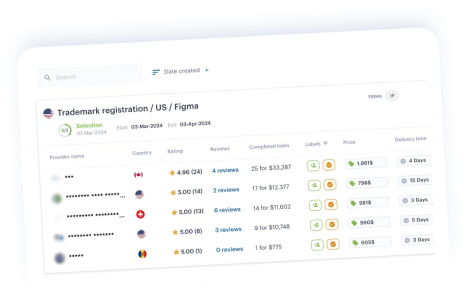Why Trademark Renewal Is Not Bureaucracy but Business Protection
A trademark renewal is much more than a formality — it is a core business safeguard. When a renewal is missed, the registration expires, and the company may lose the right to its brand entirely.
The result can be devastating: reapplication from scratch, costly rebranding, and potential disputes with competitors.
This guide explains how to renew a trademark efficiently — what timelines to follow, what documents are required, how to plan your trademark renewal fees, and how automation makes the process easier and safer for global businesses.
How Trademark Renewal Cycles Work
Trademark renewal usually follows a 10-year cycle, but the actual maintenance timeline depends on each country’s rules. In many jurisdictions, the renewal deadline is only part of the picture. Several countries also require mid-term proof of use, meaning your trademark must be actively used in commerce to stay protected.
Missing either a renewal deadline or a use declaration can lead to cancellation, even if the renewal itself is not due yet. This is why understanding the cycle is fundamental when planning how to renew a trademark and why professional trademark renewal services matter for global portfolios.
Countries and Their Use Requirements (Quick Table)
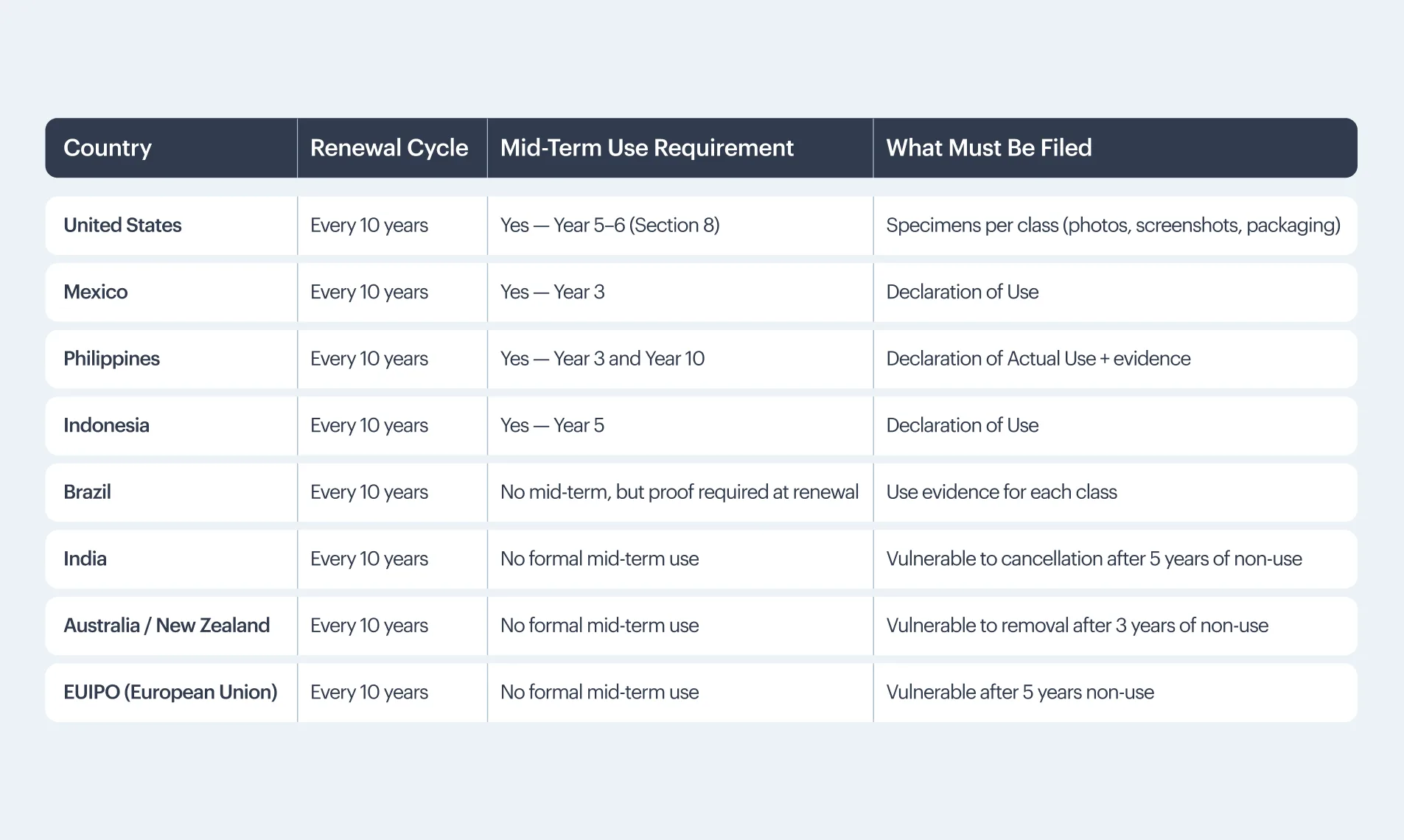
This structure creates two layers of responsibility when you renew a trademark:
1️⃣ Official 10-year trademark renewal, and
2️⃣ Periodic proofs of use, depending on the country.
A reliable trademark renewal service monitors both.
How to Provide Proof of Use
Trademark offices expect evidence of genuine, commercial use of the trademark for the goods and services listed in the registration.
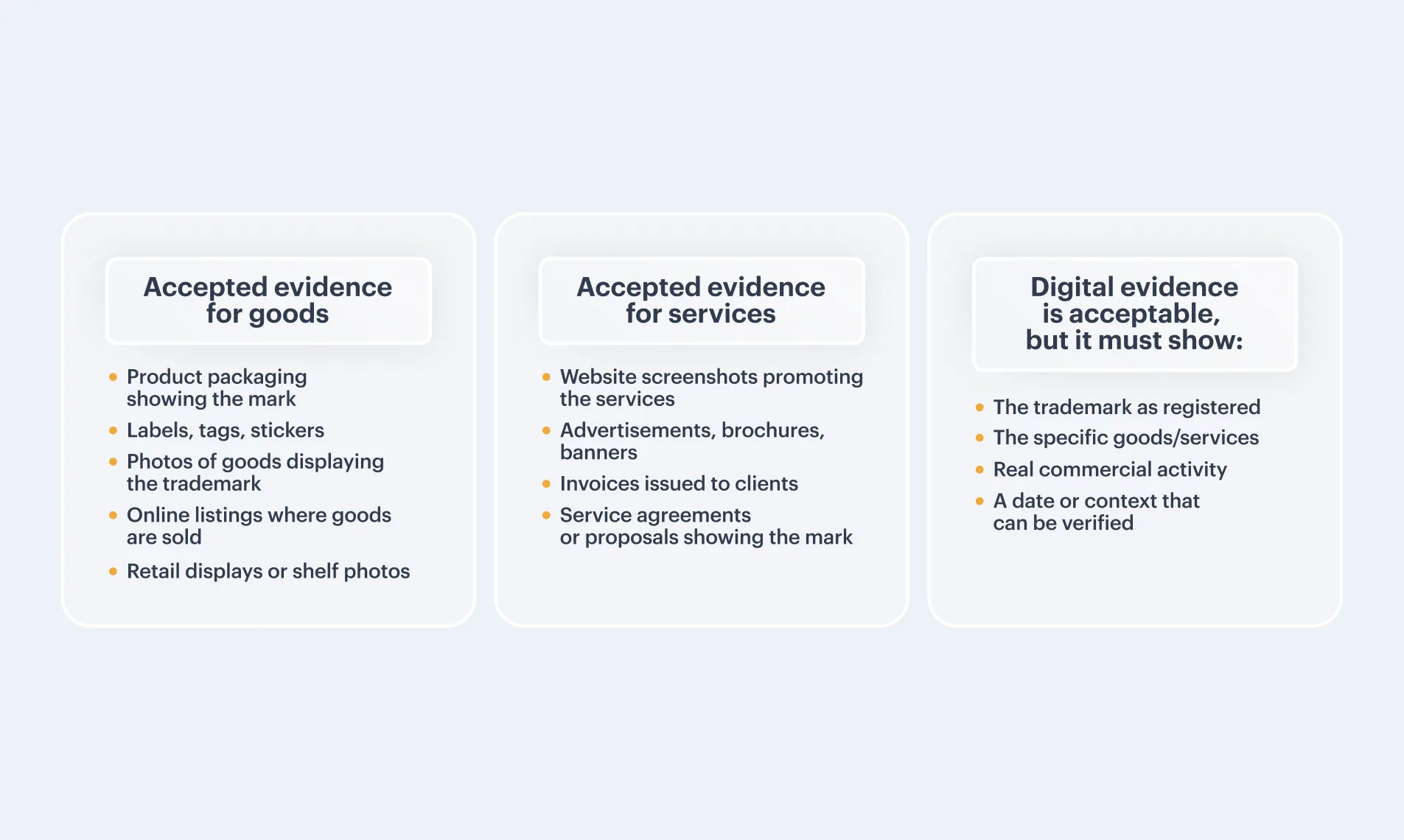
Weak or Rejected Evidence
Trademark offices routinely reject evidence that looks artificial or incomplete.
Examples include:
- Mock-ups or Photoshop layouts not used publicly
- Internal documents (internal memos, drafts, presentations)
- Packaging prototypes that never reached the market
- Website screenshots with no dates, no product pages, or no buying option
- Ads published only in social media drafts, not actually posted
- Materials showing a modified logo inconsistent with the registered mark
Using weak evidence increases the chance of refusal, forcing applicants to fight unnecessary office actions or potentially lose protection entirely.
Why Proof-of-Use Matters
Even when trademark renewal is due only every 10 years, failure to submit mandatory use declarations leads to:
- cancellation of the registration
- need to file a new trademark from scratch
- loss of priority and seniority
- risk of competitors filing identical or confusingly similar marks
- potential rebranding costs
For global brands, the safest approach is to rely on structured workflows and trusted trademark renewal services that track every obligation across jurisdictions.
Budget: what trademark renewal fees actually include
Correct budgeting for trademark renewal starts with understanding what exactly you pay for and how those costs behave across countries.
Most trademark renewal services will break the price into four main components:
1. Government fees (trademark renewal fees by country)
Government fees are the non-negotiable core of any trademark renewal. They are usually calculated per class and sometimes increase if you file in a grace period. As of late 2025, examples for one class are:
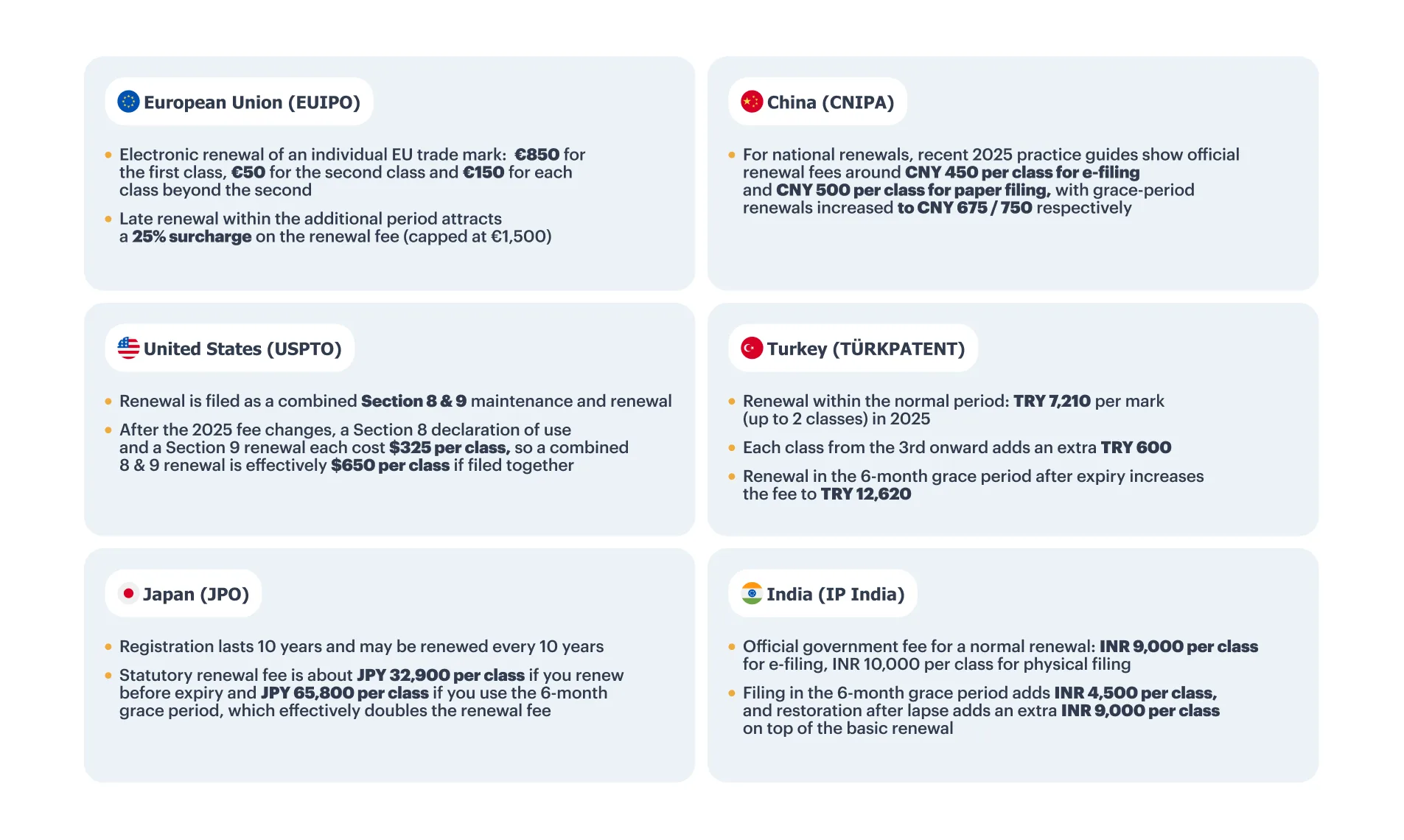
- European Union (EUIPO)
- Electronic renewal of an individual EU trade mark: €850 for the first class, €50 for the second class and €150 for each class beyond the second.
- Late renewal within the additional period attracts a 25% surcharge on the renewal fee (capped at €1,500). (EUIPO)
- United States (USPTO)
- Renewal is filed as a combined Section 8 & 9 maintenance and renewal.
- After the 2025 fee changes, a Section 8 declaration of use and a Section 9 renewal each cost $325 per class, so a combined 8 & 9 renewal is effectively $650 per class if filed together. (BIPC)
- Japan (JPO)
- Registration lasts 10 years and may be renewed every 10 years.
- Statutory renewal fee is about JPY 32,900 per class if you renew before expiry and JPY 65,800 per class if you use the 6-month grace period, which effectively doubles the renewal fee. (MARKS IP LAW FIRM)
- China (CNIPA)
- For national renewals, recent 2025 practice guides show official renewal fees around CNY 450 per class for e-filing and CNY 500 per class for paper filing, with grace-period renewals increased to CNY 675 / 750 respectively. (yciplaw.com)
- Turkey (TÜRKPATENT)
- Renewal within the normal period: TRY 7,210 per mark (up to 2 classes) in 2025.
- Each class from the 3rd onward adds an extra TRY 600.
- Renewal in the 6-month grace period after expiry increases the fee to TRY 12,620. (turkpatent.gov.tr)
- India (IP India)
- Official government fee for a normal renewal: INR 9,000 per class for e-filing, INR 10,000 per class for physical filing. (“Rest The Case”)
- Filing in the 6-month grace period adds INR 4,500 per class, and restoration after lapse adds an extra INR 9,000 per class on top of the basic renewal. (“Rest The Case”)
If your marks are registered via the Madrid System, renewal fees are paid to WIPO, using the Madrid Fee Calculator and the Schedule of Fees in Swiss francs. (madrid.wipo.int)
Even when you use a trademark renewal service, government trademark renewal fees remain the same baseline. What changes is how much margin sits on top and how clearly it is disclosed.
2. Local agent / attorney fees
In many jurisdictions, you cannot renew trademark rights directly as a foreign owner. You must work through a local trademark attorney or agent who:
- Files the renewal or combined use + renewal declaration
- Advises on use requirements and evidence (for example, in the US or some Latin American countries)
- Handles correspondence from the office
Typical patterns:
- Flat fee per mark and class for a straightforward trademark renewal
- Hourly fees for complex instructions, ownership changes or disputes
- Extra charges for monitoring grace-period deadlines or dealing with office objections
These local fees can easily match or exceed the government trademark renewal fees in some markets, so any trademark renewal services you use should show them as a separate line, not bundled into one opaque figure.
3. Service / platform fee
On top of the agent’s invoice, you usually have a coordination or platform fee. This can come from:
- A traditional law firm acting as a central coordinator
- An IP management provider
- An online platform like iPNOTE that consolidates renewals across countries
The service fee typically covers:
- Central calendar management and automated reminders (how to renew trademark on time without manual tracking)
- Consolidated invoicing in one currency for your whole portfolio
- Quality checks, escalation rules and reporting
- Use of the platform itself (user seats, dashboards, export tools)
Transparent trademark renewal services separate:
government fees + local agent fees + service/platform fees
and make it clear what you pay for each. This structure helps your finance team understand the real trademark renewal fees per country and see where they can optimize.
4. Translations and legalizations
Translations and legalizations are the silent cost driver that many companies overlook when they plan how to renew trademark portfolios globally.
You may need:
- Sworn or certified translations of:
- Powers of Attorney
- Proof of use (in some countries)
- Corporate documents if the owner’s name or address changed
- Legalization or apostille in jurisdictions that still require formally legalized PoA or corporate extracts. This happens more often in parts of the Middle East, Latin America and some Asian countries, and it can add weeks and hundreds of dollars per mark if not planned in advance.
Even when offices like the EUIPO or USPTO accept filings in one language, local agents in other jurisdictions may still charge for translating instructions, specifications or evidence. A good trademark renewal service will specify when translations are actually mandatory and when they are “nice to have,” so you do not pay for unnecessary work.
What really inflates the bill
Several factors can turn normal trademark renewal fees into a painful surprise:
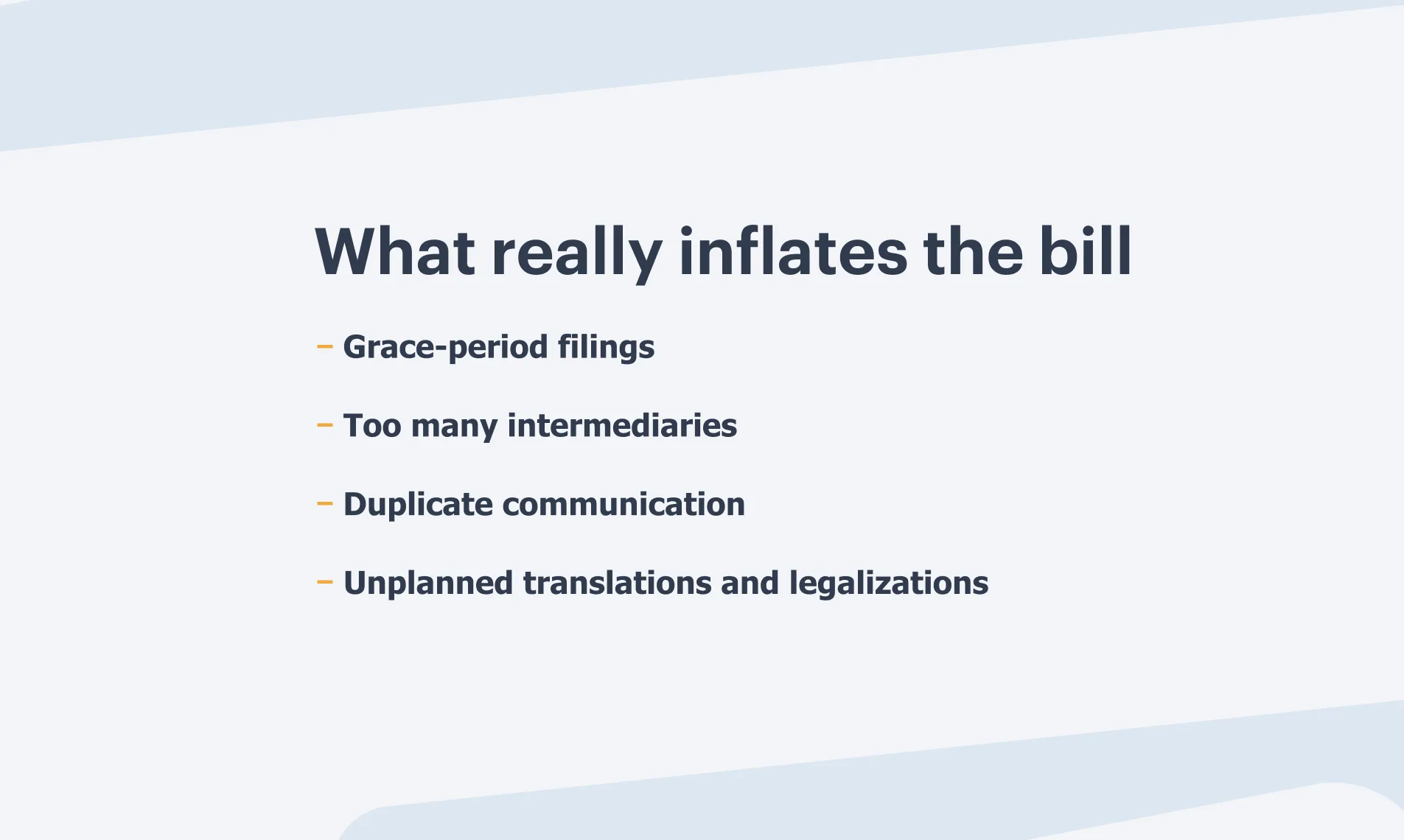
- Grace-period filings
- Almost every office charges a surcharge if you renew during the grace period.
- Examples:
- EU: up to 25% surcharge on the renewal fee. (EUIPO)
- Japan: renewal fee effectively doubles in the grace period. (MARKS IP LAW FIRM)
- India: extra INR 4,500 per class in grace, plus even higher costs for restoration. (“Rest The Case”)
- Too many intermediaries
- Brand owner → international law firm → regional firm → local agent.
- Each layer adds its own coordination fee, sometimes on the same official cost.
- Duplicate communication
- Several people reviewing the same renewal, forwarding the same office letter and billing their time.
- Unplanned translations and legalizations
- Last-minute discovery that PoA must be legalized or evidence translated before a fixed deadline.
Using a single platform for trademark renewal services and IP management helps cut these layers and makes each cost item transparent.
How to plan a 12–24 month renewal budget
To avoid budget shocks, treat renewals as a rolling forecast across your entire IP portfolio:
- Export your trademark portfolio
- Include: mark, country/office, classes, owner, next renewal date, Madrid vs national.
- Map official trademark renewal fees
- For each country, link the mark to the current official trademark renewal fees from the office or WIPO tools (EUIPO fee tables, USPTO fee schedules, JPO, CNIPA, TÜRKPATENT, IP India, Madrid Fee Calculator, etc.). (EUIPO)
- Add local agent and service/platform fees
- For each jurisdiction, assign a realistic agent fee and your internal/platform coordination fee per class.
- Group by 12–24 month horizon
- Build a calendar of all renewals due in the next 12 and 24 months.
- Sum costs by month and by country, then by business line or brand if needed.
- Apply KEEP / UPDATE / RETIRE logic
- KEEP – core brands and key markets where you renew without debate.
- UPDATE – marks where you may adjust classes, owner name or logo at renewal.
- RETIRE – markets or old versions where you plan not to renew trademark rights (Once you tag each mark, you can remove RETIRE marks from the budget and adjust fees for UPDATE marks (for example, fewer classes)).
- Lock decisions in an audit trail
-
- Record every KEEP / UPDATE / RETIRE decision, who made it and when.
- This protects you later if someone questions why a specific mark was not renewed.
A structured approach like this turns trademark renewal from a reactive fire-drill into a predictable, controllable line in your IP budget. It also gives you a clear input for a platform like iPNOTE, where automated reminders, consolidated invoices and portfolio dashboards make how to renew trademark portfolios across many countries much easier to manage.
Operational Timeline “−12 / −6 / −1 / Grace” (Expanded & SEO-Optimized, in English)
Managing trademark renewals across many countries requires a structured workflow.
Below is a detailed, practical timeline that shows not only what to do but also how much time a company spends if everything is handled manually versus using iPNOTE’s automated trademark renewal services.
−12 Months Before Renewal
What happens at this stage
- Verifying exact renewal deadlines across all jurisdictions
- Checking ownership records and address details
- Collecting proof-of-use materials for countries that require it
- Drafting a preliminary budget based on official trademark renewal fees
- Reviewing goods and classes (whether they need to be updated, narrowed, or expanded)
Why this matters
Most failed renewals in the U.S., Mexico, and the Philippines come from incorrect dates, outdated ownership data, or missing use evidence.
Without iPNOTE (manual process)
- Searching for dates in emails, PDFs, and spreadsheets
- Manually reconciling conflicting information from different team members
- Requesting confirmations from local agents (responses may take days)
- Building a budget with inconsistent currency conversions
Time required:
≈ 2–4 hours per trademark if 3–5 jurisdictions are involved
With iPNOTE
- All renewal deadlines appear in a one view
- Ownership details are verified instantly
- A preliminary budget is auto-generated based on official fees
Time required:
≈ 10–15 minutes for the entire portfolio
−6 Months Before Renewal
What happens
- Finalizing the list of goods and classes
- Checking power of attorney (POA) requirements
- Identifying required translations or legalizations
- Requesting renewal quotes from local agents
Why this matters
This step determines the real cost of renewal and prevents last-minute expenses like urgent translations or notarizations.
Without iPNOTE
- Sending individual emails to multiple agents
- Waiting days for each quote
- Comparing prices manually in Excel
- Risk of missing deadlines if an agent responds slowly
Time required:
≈ 3–6 hours per renewal when dealing with 3+ countries
With iPNOTE
- Pre-verified agents listed instantly
- Fixed-price offers visible immediately
- All countries and prices displayed in one dashboard
Time required:
≈ 5 minutes
−1 Month Before Renewal
What happens
- Paying all official trademark renewal fees
- Confirming payments and receipts
- Monitoring currency transfers and banking charges
- Ensuring proof-of-use documents are accepted
Why this matters
This is where most administrative errors occur — wrong class, incorrect owner, missing receipts, delays with international transfers.
Without iPNOTE
- Multiple invoices in different currencies
- Scattered receipts across emails
- Manual checks with each local agent
- Extra time spent coordinating with finance teams
Time required:
≈ 1–2 hours per trademark
With iPNOTE
- One consolidated invoice
- Automatic storage of receipts
- Full audit trail in the case file
- Zero manual follow-up with agents
Time required:
≈ 3 minutes
Grace Period (if applicable)
What happens
- Additional surcharges (25%–100% depending on jurisdiction)
- More urgent handling by agents
- Additional document reviews
- Strict monitoring of shortened deadlines
Why this matters
The grace period is a safety net but significantly increases cost and risk.
Without iPNOTE
- High chance of missing the second deadline
- No centralized visibility
- Confusing status updates
- More time spent coordinating with agents
Workload:
≈ 2–3× more time than a normal renewal
With iPNOTE
- Automated escalations inside the platform
- Real-time updates from agents
- Predictable costs visible in advance
Workload:
≈ minimal, since the system controls most deadlines
Time Comparison: Manual vs iPNOTE
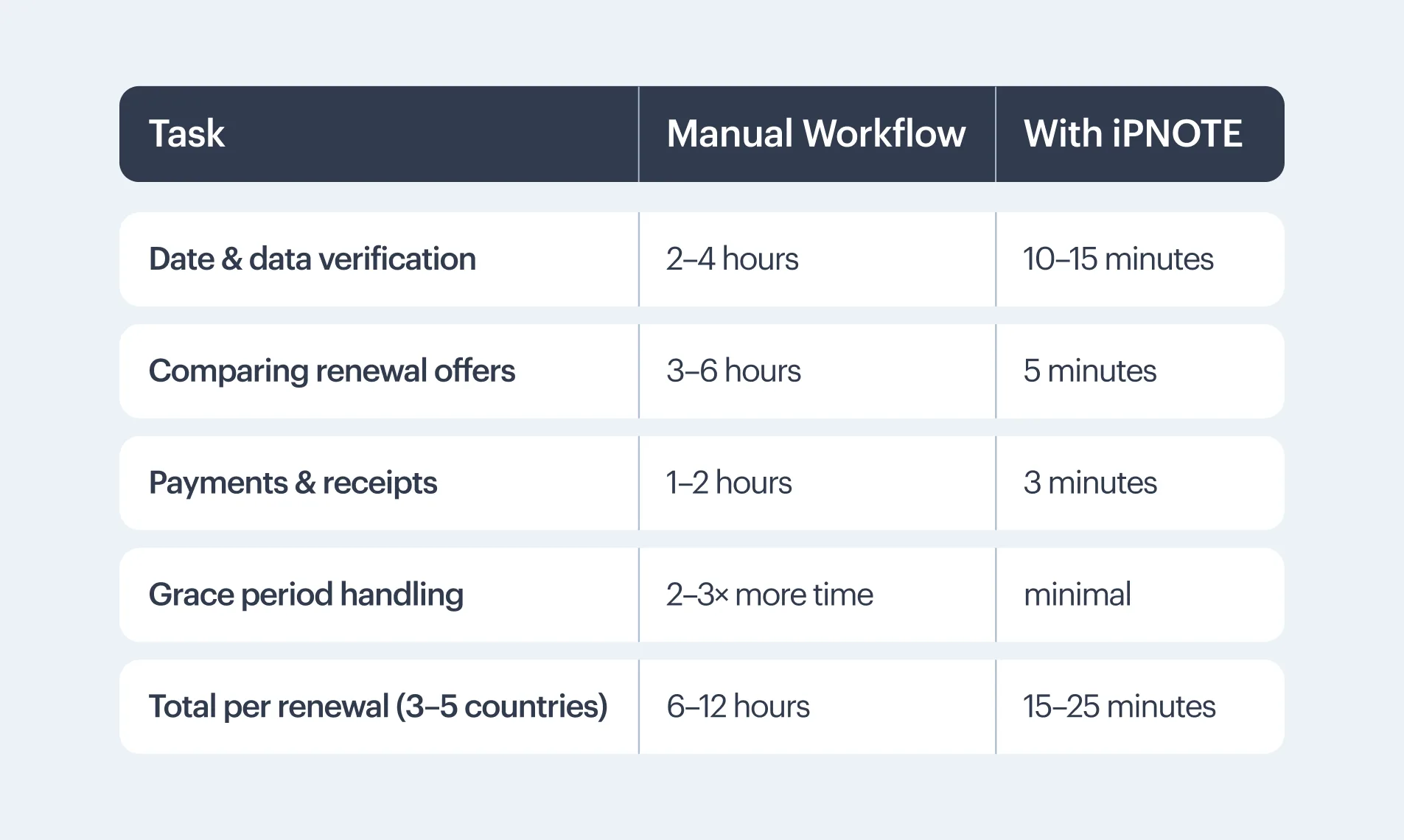
Using iPNOTE reduces operational effort by 15–30×, while improving accuracy and preventing missed deadlines.
Typical Mistakes and How to Avoid Them
- No centralized renewal calendar
Tracking deadlines through spreadsheets or emails often causes overlaps, missed dates, and time-zone errors across jurisdictions.
How to avoid: Use one centralized renewal calendar with automated reminders, jurisdiction-specific rules, and validation checkpoints at −12, −6, and −1 months. - Outdated owner or address information
Renewals are frequently delayed or rejected when registrant data does not match official records.
How to avoid: Review ownership details 6–12 months before renewal, update corporate names and addresses, and refresh POA documents where required. - Missing or unorganized proof-of-use materials
Countries such as the U.S., Mexico, the Philippines, Indonesia, and Brazil require mid-cycle or renewal-stage evidence of use.
How to avoid: Maintain a digital folder for each trademark with dated screenshots, packaging photos, invoices, and marketing materials, and keep it linked to the mark inside your renewal system. - Relying on a single agent without SLAs or backup
A single point of failure creates risks of slow responses, missed updates, and unpredictable pricing.
How to avoid: Engage at least one backup provider per country and compare agents by fixed offers, SLAs, and on-time performance through a structured trademark renewal service. - No unified record of KEEP / UPDATE / RETIRE decisions
Without a documented renewal strategy, teams may extend outdated marks or accidentally discontinue active ones.
How to avoid: Keep a single dashboard logging every decision, rationale, and supporting documents, and review the status before each annual budget cycle.
These practices minimize renewal risks, improve portfolio accuracy, and make global trademark maintenance significantly more predictable.
How iPNOTE Simplifies Trademark Renewals
iPNOTE centralizes every renewal deadline, document, and provider into one structured system, making global trademark renewals predictable and easy to manage.
Unified automated reminders
The platform combines all renewal dates across all jurisdictions into one synchronized dashboard. Automated reminders follow country-specific rules and trigger at multiple checkpoints, helping teams avoid missed deadlines and eliminating manual spreadsheets.
Accurate budget forecasting
iPNOTE calculates expected trademark renewal fees, agent costs, translations, and service charges for every mark and market. ok.
Marketplace of verified agents
The platform connects users with verified local attorneys in 190+ countries. Each provider offers fixed prices before work begins, SLA-backed timelines, escrow-protected payments, and a transparent audit log. You can switch providers instantly without losing data or progress.
Centralized documents & proof-of-use storage
All evidence, invoices, POAs, and communication threads are stored in the same trademark card, making renewal preparation fast and error-free.
Export & anti lock-in
All deadlines, documents, invoices, and communications can be exported in standard formats at any time. You always retain full ownership of your data, without vendor lock-in or hidden barriers
Conclusion
Trademark renewals protect not only your brand but also your market position and investments.
With structured planning and a reliable trademark renewal service, you ensure that every mark stays active without administrative chaos.
Upload your portfolio to iPNOTE today to receive a personalized trademark renewal calendar and cost forecast for the next 12 months.
Launch a pilot project, complete your upcoming renewal wave, and compare your results as cost, accuracy, and timing with your current process.
Renew trademarks confidently. Protect your brand globally.






